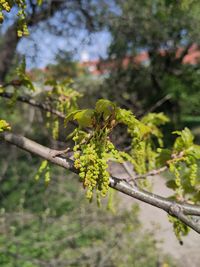Issued on April 24, 2025
Rain and sun alternate, the pollen load goes up and down!
The weather forecast promises changeable weather for the coming days. Rain washes the pollen out of the air. This provides pollen allergy sufferers with some relief. As soon as the sun comes out and dries the inflorescences, the pollen load may rise again to moderate to high levels.
Birch, ash and hornbeam have finished flowering in the lowlands. There are still flowering specimens at higher altitudes. With the right wind currents, pollen can be transported from here to the lowlands and cause problems there.
In Vorarlberg, oaks, beeches and walnuts have started to flower. All three have allergens that are related to those of the birch family. These can cause cross-reactions in people sensitized to birch plants.
For people who are sensitized to ash or olive trees, the current flowering of the lilac and the manna ash, a popular park tree, is important. Although both produce less pollen than the common ash, as they are pollinated by insects, allergy sufferers may experience symptoms in the direct vicinity of or in contact with these ornamental trees.
The plane tree also flowers. As it is a popular avenue and park tree, it is mainly found in residential areas. Here it can cause considerable local stress in sensitized people.
The first flowering specimens of annual bluegrass, foxtail grass and meadow grass have already been sighted. Full flowering is not expected until the beginning of May (see flowering model). Particularly at the beginning, some of the model data still shows a wide range of fluctuation and only becomes more reliable as the season progresses.
The white flakes that can already be seen sporadically in the air are poplar absorbent cotton. It cannot itself cause allergic reactions as it is not pollen but poplar seeds and seed hairs. The flight of poplar absorbent cotton usually coincides with the start of flowering of the grasses.
Other types of pollen in the ambient air: maple, boxwood, mulberry, roses, horse chestnut, sour grasses and cypresses. These are of minor allergological importance.
| Flowering birch | at the |
|---|---|
Alberschwende | 09.05.2025 |
Bludenz | 30.04.2025 |
Bregenz | 04.05.2025 |
Dornbirn | 04.05.2025 |
Feldkirch | 02.05.2025 |
Forecast from 24.04.2025
Note: The data shown here are model data for the expected start of flowering. For more detailed information on the expected pollen count, please refer to the text forecasts.
Responsible for the content
AZ Pollenresearch GmbH
im Auftrag der Vorarlberger Krankenhaus-Betriebsgesellschaft.
Dr. rer. nat. Johannes M. Bouchal und Lukas Dirr, MSc.
Wetterdaten und Prognosen basierend auf synoptischen Daten:
GeoSphere Austria, Bundesanstalt für Geologie, Geophysik, Klimatologie und Meteorologie (ehemals ZAMG).
zum Team


